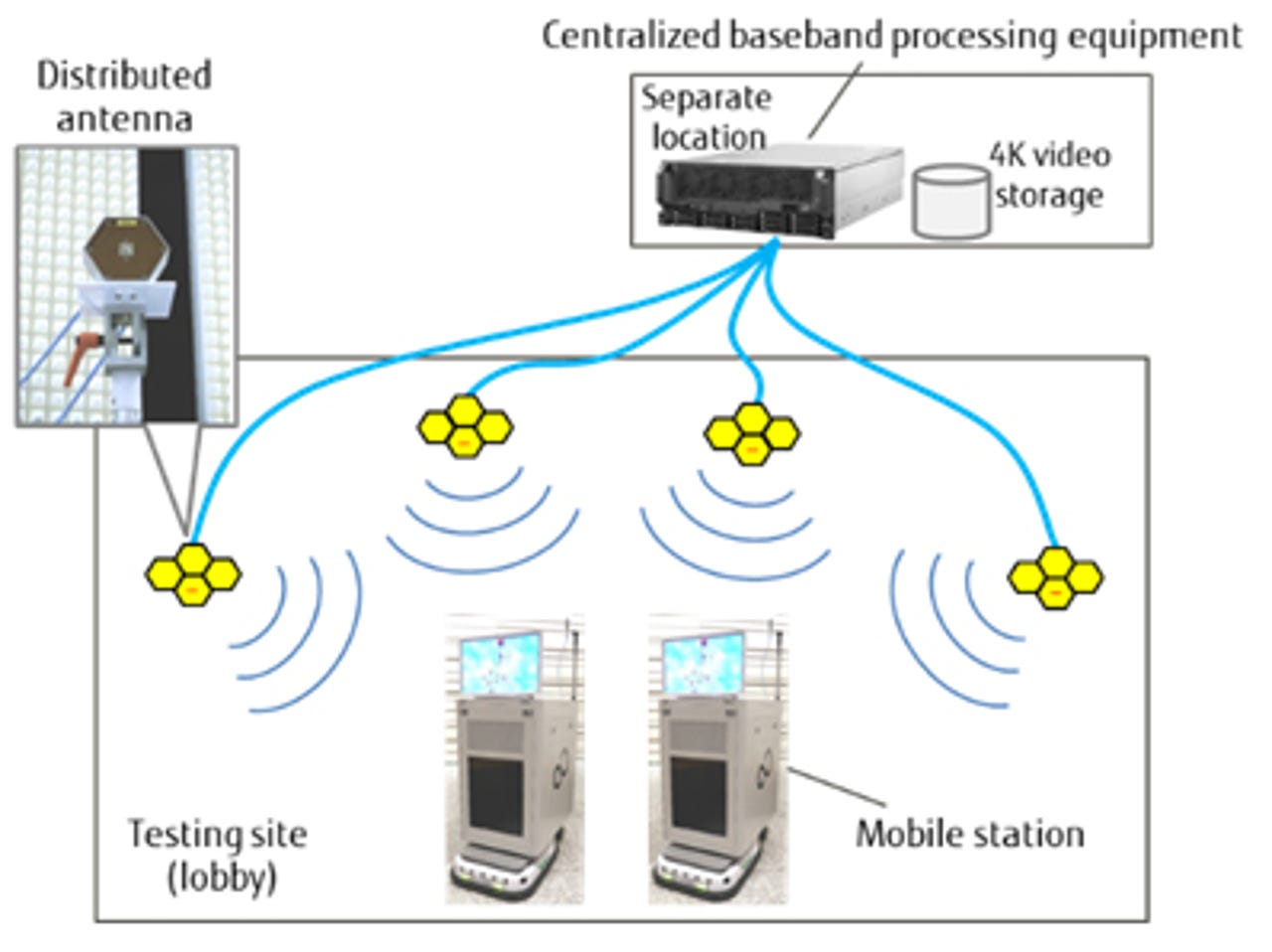Fujitsu trials 5G antenna system


Fujitsu has kicked off a field trial of its 5G ultra high-density distributed antenna technology and tests of simultaneous high-speed transmission of high-res video using the antenna system, in partnership with NTT DoCoMo.
The trial takes place at a 5G testing site at the Fujitsu Shin-Kawasaki Technology Square, one of Fujitsu's network business locations in Japan.
Fujitsu and Fujitsu Laboratories, which have been working on 5G trials with NTT DoCoMo since 2014, have already collaborated with the Japanese carrier on evaluating communications speed for distributed antennas deployed at multiple outdoor locations.
"The testing system consists of two mobile stations equipped with displays that can be moved around the interior of Fujitsu Shin-Kawasaki Technology Square, as well as equipment including distributed antennas installed in 16 locations, centralised baseband processing equipment that controls the distributed antennas, and fibre-optic cables connecting the distributed antennas with the centralised baseband processing equipment," Fujitsu explained.
Fujitsu's ultra high-density distributed antenna technology "actively controls the shape of cells, which are the range of a signal, in order to improve communication quality for mobile stations through centralised control of base station antennas distributed around a space at high density", it said.
Fujitsu said 32 distributed antennas can be controlled by the centralised baseband processing devices, using signal processing equipment that aggregates digital signals transmitted and received by several different distributed antennas while preventing signal interference.
The testing system involves placement of the distributed antennas in the lobby of the Fujitsu Shin-Kawasaki Technology Square, while the centralised baseband processing equipment is installed in another building with optical fibre.
The antennas then transmit up to 32 high-speed, high-capacity data streams at the same time to multiple mobile stations.
"At the beginning of the trial, Fujitsu will test simultaneous high-capacity transmissions of different high-resolution video to two mobile stations equipped with displays that can be moved around the lobby," the company explained.
The testing system and trials were arranged after Fujitsu was asked by the Japanese Ministry of Internal Affairs and Communications to assist in "the research and development project for realisation of the fifth-generation mobile communications system".
Fujitsu will continue working with NTT DoCoMo on 5G trials, the company said, including on live video transmission in stadiums.
NTT DoCoMo's 5G trial network is also being used for connected car testing announced earlier in the day in partnership with Intel, Ericsson, Denso, and Toyota, with the companies attaining data speeds of 1Gbps/600Mbps for 4K video streaming in a connected vehicle travelling at 30km/h.
The trial in Tokyo made use of Intel's Go 5G Automotive Platform terminal and on-board antenna head for connected car trials; Ericsson's base stations and cloud-RAN technology; NTT DoCoMo's 5G trial environment; and a Toyota Alphard vehicle.
"This accomplishment marks the first 5G multi-vendor interoperability trial involving a device connected to a base station in an automotive environment," the five companies, which formed a connected cars big data consortium in August, said.
Fujitsu's announcement on Tuesday also follows the company last month unveiling its millimetre-wave (mmWave) phase shifter for small cells, which it said delivers the 10Gbps connections required by 5G while maintaining low power usage.
According to Fujitsu, its phase shifters reduced the number of amps needed by combining switching circuits with differential amps; and using a new mmWave circuit limited the electrical loss of circuits.
"Phase shifters are circuits that determine the direction of the beam output from an antenna array by adjusting the phase of the input signal to each antenna in a range of 0 to 360 degrees. Up until now, each phase shifter has required four amps," it explained.
"Now, by developing a new switch circuit that can switch the phase of the output signal to 0 and 180 degrees, or 90 and 270 degrees through encoding a positive or negative sign into the input signal, Fujitsu Laboratories has successfully reduced the number of required amps to two."
Its small cell technology also makes use of beam-forming, with Fujitsu saying it controls 128 antenna elements.
Fujitsu is currently looking to conduct field trials and develop equipment ahead of offering a 5G small cell product by 2020.
Related Fujitsu Coverage
Fujitsu unveils small cell mmWave 5G tech
Fujitsu has announced its new mmWave circuit technology which makes use of small cell and beam-forming solutions to enable the 10Gbps speeds needed for 5G while maintaining power usage of just 3W.
Lenovo snaps up majority stake in Fujitsu PC business
The company also managed to beat analyst expectations in Q2 2017.
Fujitsu to provide AIST with supercomputer for AI applications
Japan's National Institute of Advanced Industrial Science and Technology will be using its new supercomputer system to accelerate R&D in areas such as artificial intelligence.